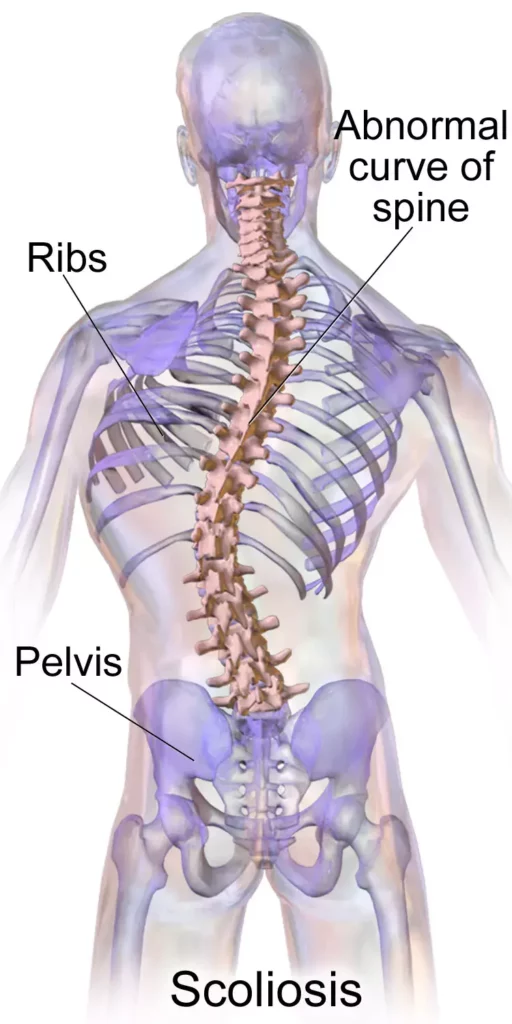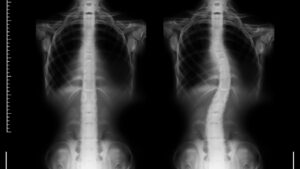Scoliosis is a deformity of a spine where it is curving sideways, giving an appearance of a ‘C’ or ‘S-shaped spine when looked at from the frontal and/or back view (normally straight in such view). Unfortunately not much is known about the exact cause of scoliosis, hence the name ‘idiopathic scoliosis’ which idiopathic denotes “unknown cause” for the majority of scoliosis cases. Consequently, scoliosis can invariably be accompanied by various undesirable outcomes as it gets worse over time into adulthood.
At Healing Hands Chiropractic, we can help those suffering from scoliosis by managing the debilitating effects resulting from scoliosis, as well as preventing it from getting worse. It’s imperative that cases or suspected cases of scoliosis be known for preventative reasons at the early stages of the condition which can start as early as nine years old.

Facts about Scoliosis
Common types of scoliosis include:
- Idiopathic: unknown origin
- Congenital: present since birth due to birth defects i.e. in the spinal bones.
- Neuromuscular: caused by nerve or muscle-related issues such as cerebral palsy or muscular dystrophy
- Degenerative: due to degeneration in bones and joints
- Functional: actually normal spine that appears to be curved due to other problems such as uneven leg length, abnormal weight-bearing, or muscle spasms on one side of the spinal muscles.
Common Causes of Scoliosis
The exact cause of scoliosis still remains largely unknown, hence why idiopathic scoliosis is the most common type (about 80%) while the rest is relatively rare. It most commonly affects children and adolescents, especially around the time of their growth spurts before puberty (age 9-15). But it can still arise in people who are both younger and older than such age.

It can often be undetected during the early stage as the curve may not significantly be severe enough to notice or cause symptoms such as but not limited to shortness of breath, one shoulder blade protruding out or more lowered than the other. The diagnosis of scoliosis is confirmed by imaging studies such as X-rays to determine its severity and the size or degree of the curve which is measured to be 10 degrees or more. A child in the early stages may be required to have regular imaging checks(X-rays) in order to assess the progression of scoliosis. If scoliosis is showing any of the following characteristics, it is regarded as a possible serious issue that can warrant referral to a medical specialist for further evaluation to eliminate possible implications of the condition.
- The degree of the scoliosis is twenty-five (25) degrees or more
- The degree of the scoliosis is shown to be progressing upon subsequent examinations
- It is curving to the left side in the chest area (heart/cardio implications will be a concern)
Detecting and managing scoliosis early is vital especially in children as their bones and joints have not fully matured and are still growing. Consequently, this puts them at a greater risk of their scoliosis progressing to a larger degree, due to poor postural habits, lack of ergonomics during studying, exercise, etc. This will present more severe symptoms that are more likely to persist into their adulthood if the condition is not managed correctly, effectively, and efficiently.
As mentioned above, adults can experience and/or have scoliosis as well. These cases are due to scoliosis continuing on from childhood, to ageing and/or degeneration naturally and prematurely in the spine which result in structural imbalance, deformity and instability due to neuromusculoskeletal impairments and conditions.
Signs and Symptoms of Scoliosis
Here are some of the signs and symptoms associated with scoliosis:
- Uneven positioning of body parts (tilted head/shoulders/hips, uneven leg length, humps in the rib cage/shoulder blade) e.g. from sitting too long in front of a computer, notebook, from studying etc.
- Imbalance in muscle tone: can lead to Stiffness and reduced range of motion (lack of stretching, poor ergonomics etc)
- Poor posture
- Pain in the neck, shoulders, back, and hips
- Abnormal stress on internal organs causing disturbance in their functions (heart problems, breathing difficulty, constipation, painful menses, and etc.)
- Higher risk of degeneration of bones and joints in the spine
- Lower self-esteem due to the deformed appearance of the overall body shape
How can Scoliosis be treated?

How can Chiropractic Treatment help?
Although chiropractors do not necessarily aim to ‘straighten’ the abnormal curve of a scoliosis condition, we can still help in managing it so that it does not become an unnecessary burden in your life or manage it from getting worse. Our goal is to allow you to live a life without restrictions and for you to live it to the fullest regardless if you have scoliosis.
With Healing Hands, we work together with you and your child to make this happen through physical education and develop good postural, exercise and ergonomic habits that will allow you, the patient to decide what’s best for your body and health in the long run.
Our treatment is designed to help restore the alignment and functional movements of the spinal joints which can reduce the strain on both the spine and the rest of the body through better movement and function. Additionally, our treatment approach and your personal commitment to your health can help your body and spine to stabilize the progression of scoliosis so that it does not prematurely deteriorate, weaken and lead to more severe symptoms or other associated problems.
With every individual patient that comes through Healing Hands, our chief focus is prevention. To help each individual know the cause of their pain, symptoms and/or conditions first and foremost and to give each individual a chance in addressing their health concerns naturally to prevent having to suffer the long term consequences of scoliosis or any other conditions. Healing Hands is committed to this ideal, to your health, and most of all you; our patient(s).
“Remember, PAIN is a warning signal and is the LAST symptom to appear. If left untreated, it becomes CHRONIC”



